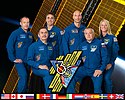Expedition 36
| Expedition 36 | |||
 | |||
| Uppdragsstatistik | |||
|---|---|---|---|
| Rymdstation: | ISS | ||
| Start: | 13 maj 2013[1] | ||
| Slut: | 10 september 2013[1] | ||
| Antal besättningsmedlemmar: | 6 st | ||
| Rymdpromenad | |||
| Antal rymdpromenader: | 5st | ||
| Total tid: | 28 timmar | ||
| Transport | |||
| Uppskjutning: | med Sojuz TMA-08M, Sojuz TMA-09M | ||
| Uppskjutningsplats: | Kosmodromen i Bajkonur | ||
| Landning: | med Sojuz TMA-08M, Sojuz TMA-09M | ||
| Landningsplats: | Kazakstan | ||
| Kronologi | |||
| |||

Expedition 36 var den 36:e expeditionen till Internationella rymdstationen (ISS). Expeditionen började den 13 maj 2013 då delar av Expedition 35s besättning återvände till jorden med Sojuz TMA-07M.
Karen L. Nyberg, Fjodor Jurtjichin och Luca Parmitano anlände till stationen med Sojuz TMA-09M den 29 maj 2013
Expeditionen avslutades den 10 september 2013 då Pavel Vinogradov, Aleksandr Misurkin och Christopher J. Cassidy återvände till jorden med Sojuz TMA-08M.
Besättning
| Position | Första delen (13 maj - 29 maj 2013) | Andra delen (29 maj - 10 september 2013) |
|---|---|---|
| Befälhavare | Hans tredje rymdfärd | |
| Flygingenjör 1 | Hans andra rymdfärd | |
| Flygingenjör 2 | Hans andra rymdfärd | |
| Flygingenjör 3 | Hennes andra rymdfärd | |
| Flygingenjör 4 | Hans fjärde rymdfärd | |
| Flygingenjör 5 | Hans första rymdfärd | |
Referenser
- ^ [a b] NASA's Space Station Expedition 36 Arkiverad 27 februari 2020 hämtat från the Wayback Machine., läst 3 september 2016.
Externa länkar
| |||||||||||||||||||
Media som används på denna webbplats
Expedition 36 crew members take a break from training at NASA's Johnson Space Center to pose for a crew portrait. Pictured on the front row are Russian cosmonauts Pavel Vinogradov (left), commander; and Fyodor Yurchikhin, flight engineer. Pictured from the left (back row) are Russian cosmonaut Alexander Misurkin, NASA astronaut Chris Cassidy, European Space Agency astronaut Luca Parmitano and NASA astronaut Karen Nyberg, all flight engineers.
Emblazoned with a bold 35 for the 35th expedition to the International Space Station (ISS), this patch portrays a natural moonlit view of the Earth from the ISS at the moment of sunrise, one of the sixteen that occur each day at orbital velocity, with glowing bands of Earth's atmosphere dispersing the sun's bright light into primary colors. The Earth is depicted as it often appears from space, without recognizable coastlines or boundaries - just as the international endeavor of living and working together in space blurs technical and cultural boundaries between nations. The ISS is the unseen central figure of the image, since the view is from a window of the Space Station itself, commemorating full use of the Space Station as a long-duration dwelling from which humans can develop techniques and technologies to further explore. The crew points out, "The arc of the Earth's horizon with the sun's arrows of light imply a bow shooting the imagination to Mars and the cosmos where our species may one day thrive."
The dynamic design of the Expedition 36 patch portrays the International Space Station's (ISS) iconic solar arrays. The slanted angles denote a kinetic energy leading from the Earth in the lower right to the upper left tip of the triangular shape of the patch, representing the infinite scientific research, education, and long-duration spaceflight capabilities the ISS provides with each mission, as well as our goal for future exploration beyond the Space Station. The numbers 3 and 6 harmoniously intertwine to form expedition number 36 and its gray coloration signifies the unity and neutrality among all of the international partners of the ISS. The blue and gold color scheme of the patch represents the subtle way the central gold orbit wraps around the number 36 to form a trident at its lower right tip. The trident also symbolizes the sea, air, and land, all of which make up the Earth from where the trident originates in the design.
Leonardo da Vinci's Vitruvian Man, created some 525 years ago, as a blend of art and science and a symbol of the medical profession, is depicted amongst the orbits of a variety of satellites circling the Earth at great speed. Da Vinci's drawing, based on the proportions of man as described by the Roman architect Vitruvius, is often used as a symbol of symmetry of the human body and the universe as a whole. Almost perfect in symmetry as well, the International Space Station, with its solar wings spread out and illuminated by the first rays of dawn, is pictured as a mighty beacon arcing upwards across our night skies, the ultimate symbol of science and technology of our age. Six stars represent the six members of Expedition 37 crew, which includes two cosmonauts with a medical background, as well as a native of Da Vinci's Italy.






